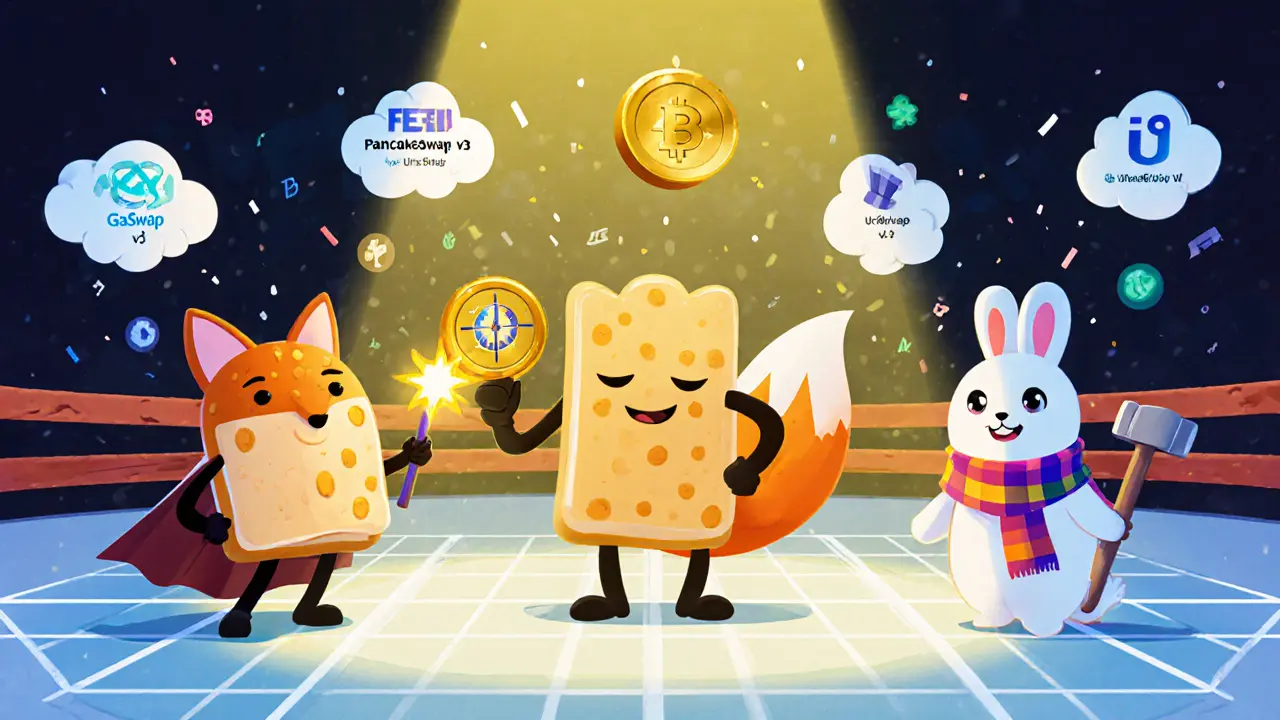 Oct, 7 2025
Oct, 7 2025
Ethereum Gas Cost Calculator
Estimate your transaction costs on Ethereum networks based on current gas prices. This calculator shows how gas costs impact trades on PancakeSwap v3 compared to Uniswap v3 and PancakeSwap v2 (BSC).
Estimated Transaction Cost
Ever wondered whether a DEX that started on Binance Smart Chain can really hold its own on Ethereum? PancakeSwap v3 tries to answer that question by bringing its multi‑chain DeFi suite to the Ethereum ecosystem. In this review we’ll break down how the platform works, what makes it different, and whether the extra gas fees are worth it.
What is PancakeSwap v3 on Ethereum?
PancakeSwap v3 is a decentralized exchange (DEX) that operates as an automated market maker (AMM) on multiple blockchains, including Ethereum, Base, and Solana. The Ethereum version inherits the same feature‑rich DeFi ecosystem that made the original BSC platform popular, but it runs on a network with higher security guarantees and broader token listings. Users stay in full control of their private keys, and trades happen directly from their wallets without any custodial intermediary.
Core Features That Set It Apart
Below are the headline capabilities that define PancakeSwap v3 on Ethereum.
- Concentrated Liquidity lets liquidity providers (LPs) allocate capital to narrow price ranges, boosting capital efficiency compared to full‑range pools.
- Smart Order Routing automatically scans multiple pools to find the best price, reducing slippage for large trades.
- Limit Orders enable traders to set a target price; the order executes automatically once the market reaches that level.
- Tiered fee structure - many Ethereum pairs show
0.00% takerand0.00% makerfees, though users still pay Ethereum gas.
How It Compares to Other Ethereum DEXs
Uniswap v3 pioneered concentrated liquidity, so any comparison must include it. Below is a quick side‑by‑side look.
| Feature | PancakeSwap v3 (Ethereum) | Uniswap v3 | PancakeSwap v2 (BSC) |
|---|---|---|---|
| Concentrated Liquidity | Yes - same algorithm as Uniswap v3 | Yes - original implementation | No - full‑range only |
| Smart Order Routing | Built‑in across multiple pools | Limited to a single pool per trade | Not available |
| Limit Orders | Supported for fee‑free tokens | Supported via external routers | Not supported |
| Fee Structure | 0% taker/maker on many pairs (gas remains) | 0.05%‑0.30% pool‑specific | 0.20%‑0.30% flat |
| DeFi Suite | Yield farms, syrup pools, IFOs, NFT marketplace, futures | Limited to swaps & liquidity | Yield farms, lottery, prediction markets |
| Average Gas Cost (Oct2025) | ~45gwei (~$80 per swap) | ~40gwei (~$70 per swap) | ~5gwei (~$1.10 per swap) |
While Uniswap v3 still leads in pure trading volume, PancakeSwap v3 distinguishes itself with a richer ecosystem of farming, staking, and derivative products. The trade‑off is higher gas costs compared to its BSC counterpart.

Getting Started - A Walkthrough
Here’s what the average user does the first time they open PancakeSwap v3 on Ethereum.
- Install a compatible wallet. The most common choices are MetaMask and Trust Wallet. Both inject a Web3 provider into the browser.
- Navigate to the official PancakeSwap website (always double‑check the URL).
- Click “Connect Wallet”, pick your wallet, and approve the connection.
- For a simple token swap, select the “Swap” tab, choose the input and output tokens, set a slippage tolerance (usually 0.5%-1% works), and hit “Swap”. Confirm the transaction in your wallet and wait for the block confirmation.
- If you want to provide liquidity, go to the “Liquidity” page, pick a pool, and decide whether to use full‑range or a concentrated range. The interface will show the estimated capital efficiency and the potential impermanent loss.
- Advanced users can explore “Limit Orders” or “Futures” from the side menu. Remember that limit orders stay open until hit or manually cancelled.
All actions are signed locally; the DEX never holds your assets. However, you do pay the usual Ethereum gas fee for each on‑chain transaction.
Risks, Security, and Best Practices
Because PancakeSwap v3 is unregulated, the onus is on you to stay safe. Here are the top things to watch out for:
- Smart‑contract risk: Even audited code can contain bugs. Keep only the amount you’re comfortable losing in any single pool.
- Gas‑price spikes: During network congestion, a swap that looks cheap on paper can become $200+ due to gas. Consider using layer‑2 bridges or waiting for off‑peak hours.
- Impermanent loss: Concentrated liquidity magnifies both gains and losses. Use the built‑in calculator to estimate the impact before committing.
- Phishing sites: Always verify the URL (https://pancakeswap.finance) and avoid clicking links from unknown Discord servers.
For added safety, enable hardware‑wallet support (Ledger or Trezor) when moving large sums. That way the private key never leaves the device.

Future Outlook and Roadmap
The team behind PancakeSwap has laid out several upgrades for the Ethereum version:
- Customizable expiration dates for limit orders, giving traders finer control over order lifespan.
- New yield‑farming pools that pair Ethereum‑native tokens with low‑volatility stablecoins, aiming to attract risk‑averse LPs.
- Integration with emerging layer‑2 solutions such as Optimism and Arbitrum to cut gas fees while retaining the same UI.
- Expanded derivatives suite, including options markets that will sit alongside the existing perpetual futures.
If these plans materialize, PancakeSwap v3 could close the cost‑gap with Uniswap while keeping its broader DeFi toolkit. The biggest hurdle remains user education - many traders still struggle with the nuances of concentrated liquidity and advanced order types.
Key Takeaways
- PancakeSwap v3 brings the BSC‑originated DeFi suite to Ethereum, offering concentrated liquidity, smart order routing, and zero‑fee swaps on many pairs.
- Gas costs on Ethereum are substantially higher than on BSC, so the platform is best for users who value the richer feature set over cheap trades.
- Compared with Uniswap v3, PancakeSwap shines in its ancillary products (farms, IFOs, NFTs) but lags slightly on raw swap volume.
- Security is user‑driven; always audit contracts, use reputable wallets, and consider hardware‑wallet protection.
- Upcoming layer‑2 integration could make PancakeSwap v3 a serious contender for long‑term Ethereum DeFi use.
Frequently Asked Questions
Is PancakeSwap v3 on Ethereum safe to use?
The platform is open‑source and has undergone several audits, but because it is unregulated you must do your own due diligence. Use reputable wallets, keep only small amounts in risky pools, and consider hardware‑wallet protection for large balances.
How do I connect my wallet to PancakeSwap v3?
Open the PancakeSwap website, click “Connect Wallet”, pick MetaMask, Trust Wallet, or another Web3‑compatible wallet, and approve the connection request in the wallet popup.
What is concentrated liquidity and why should I care?
Concentrated liquidity lets LPs place funds in a narrow price band instead of across the whole curve. This boosts capital efficiency, meaning you can earn higher fees with less capital-but it also requires more active management to avoid impermanent loss.
Are there any fee advantages on Ethereum compared to other DEXs?
Many pairs on PancakeSwap v3 list 0% taker and maker fees, which is attractive. However, you still pay Ethereum gas for every transaction, which can outweigh the fee savings during periods of high network demand.
Will PancakeSwap v3 support Layer‑2 networks?
The roadmap mentions integration with Optimism and Arbitrum. Once live, users will be able to trade on Ethereum’s Layer‑2s with significantly lower gas while keeping the same UI and feature set.
Shikhar Shukla
October 7, 2025 AT 13:19Upon meticulous examination of PancakeSwap v3's migration to Ethereum, it becomes evident that the platform has not sufficiently justified the substantial escalation in transaction costs. The author appears enamoured with feature parity, yet neglects to address the core economic inefficiencies introduced by the Ethereum gas model. Consequently, one must question whether this endeavor truly serves the interests of the discerning DeFi participant.
Deepak Kumar
October 21, 2025 AT 11:19Alright, folks, let’s break this down step by step so you can see why PancakeSwap v3 on Ethereum might actually be worth your time. First, the concentrated liquidity feature mirrors Uniswap v3, but PancakeSwap adds its Smart Order Routing which sweeps across multiple pools to land you the best price – that alone can save you a few basis points on large trades.
Second, the zero‑fee structure on many pairs is a game‑changer when you factor in the usual 0.05‑0.30% taker fees on other DEXs; you’re essentially paying only the gas, which, while higher on Ethereum, is still predictable if you trade during off‑peak windows.
Third, the broader DeFi suite – farms, IFOs, NFT marketplaces, and futures – gives you a one‑stop shop, reducing the need to hop between disparate protocols and exposing you to cross‑product synergies.
Also, remember that the platform supports hardware wallets; using a Ledger or Trezor can mitigate the risk of private‑key exposure while you manage larger positions.
From a user‑experience standpoint, the UI feels familiar to BSC veterans, so onboarding friction is minimal, and the “Connect Wallet” flow works seamlessly with MetaMask and Trust Wallet.
Now, let’s talk risk: concentrated liquidity does amplify impermanent loss, but the built‑in calculator can help you gauge exposure before you commit capital.
Moreover, the smart order routing reduces slippage, which is particularly valuable for volatile meme tokens that often experience thin depth on single‑pool DEXs.
Gas fees remain the elephant in the room; however, the upcoming Optimism and Arbitrum integrations promise to slash those costs dramatically, making the platform future‑proof.
In practice, I’ve seen users earn upwards of 15‑20% APR on select farms while only paying a few dollars in gas during low‑traffic periods.
If you’re a liquidity provider, the tiered fee structure means you can pick zero‑fee pools to maximize net returns.
On the other hand, if you’re simply swapping, the zero‑fee advantage may be negated by gas spikes, so timing your trades is crucial.
Overall, PancakeSwap v3 on Ethereum strikes a compelling balance between feature richness and cost, especially for power users who can manage gas strategically.
For newcomers, start with a small amount, test the limit‑order feature, and gradually expand as you become comfortable with the nuances.
Stay vigilant about phishing sites, verify URLs, and consider using a hardware wallet for anything above a few hundred dollars.
In summary, the platform is a solid addition to the Ethereum DeFi ecosystem, provided you respect the gas dynamics and leverage the broader suite of tools it offers.
Matthew Theuma
November 4, 2025 AT 08:19Interesting take, feels like a new frontier 🌌 in DeFi.
Carolyn Pritchett
November 18, 2025 AT 06:19This so‑called “multichain” experiment is nothing but a gimmick, a cheap copy of Uniswap that thinks adding farms makes it superior. The gas fees alone are a nightmare for anyone who isn’t a whale, and the “zero fee” claim is a marketing lie designed to lure clueless newcomers into a trap.
Jason Zila
December 2, 2025 AT 04:19The architecture combines AMM efficiency with advanced routing, which theoretically should reduce slippage on large orders, yet the real‑world data still shows higher average transaction costs compared to native Uniswap trades. Users must weigh the convenience of bundled DeFi services against the raw cost of gas, especially during network congestion.
Pierce O'Donnell
December 16, 2025 AT 02:19Looks like another hype cycle; I’ll stick with the tried‑and‑true.